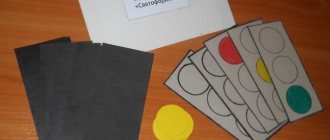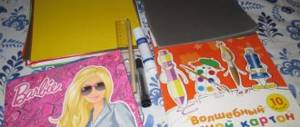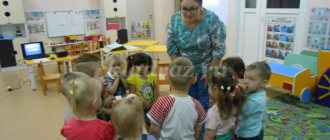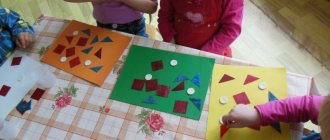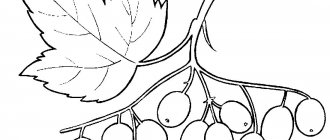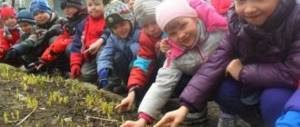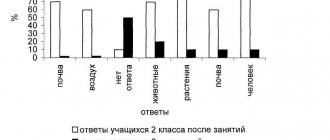As summer begins, more and more children are left to their own devices. Parents go to work or let their children go out for the whole day. Some send their children to a children's day camp. But even there, teachers do not always know what to do with a large group of children. They invite children to learn funny chants that can be used on the way to the cafeteria or to exercise. Or dating games like “Autograph”. But what to do with the kids the rest of the time? So that the children are always passionate about something new and interesting.
We offer you an active game “Traffic Light”, which is ideal for a cheerful large group of bored children. It can be played by any number of participants, regardless of age. Everyone will have fun.
There are several options for this fun. Let's talk about them in order.
Game as a form of teaching primary preschoolers the basics of traffic rules in kindergarten
A game is a child’s “work” in which he recreates other types of human activity. The productivity of game-based learning techniques is determined by the very essence of the game - it is voluntary, carries a sense of freedom and pleasure for the child.
Play is a source of development and creates a zone of proximal development. Essentially, a child moves through play activities. Only in this sense can play be called a leading activity, that is, one that determines the development of the child.
L. S. Vygotsky
“Game and its role in the mental development of a child”
The purpose and objectives of gaming activities according to traffic rules
The main goal that the teacher should focus on is the formation of the child’s readiness and ability to behave safely as a road user based on compliance with traffic rules.
In traffic rules games, preschoolers simulate real-life situations
The main objectives of training traffic rules:
- to focus the attention of parents and children on the importance of learning traffic rules from early childhood;
- to form a child’s understanding of the importance of the problem of correct behavior on the road;
- to develop in children knowledge and skills of safe behavior in different situations of the urban transport environment.
Games on traffic rules in the first junior group of kindergarten
In kindergartens, the basics of safe behavior in an urban transport environment begin to be instilled in pupils in the third year of life. It is advisable that parents begin such education at home, long before the child enters kindergarten. When starting to introduce your child to the rules of the road, it is recommended to take into account that the training is carried out “from simple to complex”; didactic materials should be presented in a playful way and correspond to the age and interests of the child.
Age-related characteristics of the mental development of children 1.5–3 years old
Early age is the period from one to 3 years, which corresponds to the first youngest group of preschool educational institutions (1.5–3 years). An important feature of early childhood is the close relationship between health, physical and mental development. The child’s emotional discomfort upon entering kindergarten causes regression of psychomotor development, worsening sleep, weight loss, and illness.
The period is also characterized by the intensive development of the child, his plasticity, which means high adaptability to external changes. The development potential is very high, but missed development opportunities during early childhood will require more significant pedagogical efforts in the future or will be lost forever. The rapid development of a child in the first 3 years of life depends entirely on the influence of an adult. Unfortunately, many underestimate the significance of this period.
The authors of “early development” systems believe that by the age of three a child can learn to read, learn several languages, master playing a musical instrument and other skills.
Table: card index of traffic rules games for the first junior group
| Name | Type of game | Progress of the game |
| "Tram and traffic light" | Mobile (medium mobility) | The game is aimed at children of the lower age limit of the early childhood period. The teacher offers to play “tram”, where he is the driver of the carriage, and the children are the carriages. Children stand in a column one after another, holding on to the clothes of the person in front, the first child holding on to the teacher. With the words “Let’s go” the movement begins. From time to time the teacher stops and says: “The little red traffic light is on, he tells you to let the pedestrian pass!” The movement begins with the words: “The green light gives us the way!” |
| “Build a traffic light” (simplified version) | Didactic - desktop-printed | Children are asked to assemble a traffic light by placing circles of the corresponding color on the template. For example, a template can be made in the colors of a traffic light, and the child must match the colors, or the template can be monochromatic (white), and the child must reproduce the layout of the traffic light from a sample or memory. |
| “Assemble a traffic light” (complicated version) | Didactic - desktop-printed | Children are offered game material in the form of multi-colored circles, from which they must choose red, yellow and green, and create a traffic light layout by laying out the circles in a certain sequence. |
| "Traffic Light Colors" | Mobile (medium mobility) | The presenter, who can be a child, shows objects (any) of one of three colors (green, red, yellow), the rest of the children demonstrate the reaction specified by the rules (can be any). For example, a green ball - clap your hands; yellow ball - raise your hands up; red ball - don't move. |
| "Hurry up to take a seat" | Movable (high mobility) | The teacher lays out hoops (green, yellow, red) on the floor. Children stand in the center of the hoop. The presenter says: “One, two, three - run into the traffic light!” The child who did not have time to take the circle becomes the leader. |
| "Let's cross the road" | Movable (high mobility) | A road is depicted on the floor. The teacher alternately shows circles with images of green and red men. Children cross the “road” at the permission sign. |
| "Traffic light" | Mobile (low mobility) | The presenter gives the children yellow, green, and red mugs. The action says sequentially: let's go, get ready, stand, and the children show the corresponding circles and explain what each signal means. The winner is the one who correctly shows all the circles and talks about the purpose of the colors. |
| "Traffic light cat and pedestrian mice" | Movable (high mobility) | All participating children pretend to be mice. Except for the “cat”, who sits on a chair and alternately names/shows the colors of the traffic light. When the color turns green, the “mice” run to their holes (scatter in different directions); on yellow - they jump in place; on red - they don’t move, they stand still. Those who are inattentive and do not obey the traffic lights become prey to the “cat” - they are eliminated from the game. |
These rule games are aimed at solving such educational problems as:
- familiarization with the structure of a traffic light, its color scheme;
- gaining knowledge about the operation of traffic lights and the rules for crossing the street;
- developing skills to act in accordance with a traffic light signal.
Didactic printed board games for children of the third year of life are simple paired pictures that need to be found among a small number of other pictures.
Children of the third year of life play with interest a simple lotto with paired pictures, and at the same time learn traffic rules
For kids, you can offer the lotto game “Halves,” which consists of pictures cut in half with images of road signs. By collecting a picture, the child remembers the signs and, with the help of the teacher, learns their meaning. Subsequently, the knowledge gained will become skills and habits of correct behavior on the city streets.
Didactic material for the board game on traffic rules “Halves” introduces children to road signs
A simple game “Assemble a traffic light” for three-year-old children is based on assembling a traffic light model according to a sample. Required game material: template, circles of three colors (red, yellow, green).
For the didactic game “Assemble a traffic light” you will need colored circles and a traffic light template
An integral part of pedagogical technologies is praise. An adult is a key figure for a child of early childhood; his assessment and support largely determine the further vector of the child’s personality development.
After the children have assembled the traffic light model, the teacher can conduct a themed outdoor game with the children.
Organization of gaming activities requires preliminary preparation in the form of notes. Working on notes allows the teacher to structure the game situation, select the optimal game material, organize the game space, and clearly formulate the desired educational results.
Table: summary of the outdoor game “Traffic Light” in the first junior group
| Author | Akatieva L.V. |
| Tasks |
|
| Planned results |
|
| Materials and equipment |
|
| Motivational stage | Q: Guys, we have a guest today. Guess who he is? (Shows an illustration of a traffic light, asks a riddle about the traffic light).
Children guess. A guest appears - a traffic light. |
| Content stage | V.: Traffic light, will you play your favorite game with the guys? (Agrees). Game "Traffic Light". Children stand at a pedestrian crossing, preparing to cross the street. The traffic light shows a red signal:
Q: Can I cross the road? The children stand still. The traffic light shows a yellow signal. The children stand still. The traffic light shows a green signal:
Q: Can I cross the road? Children cross the road at a zebra crossing. The game is repeated several times. V.: Thank you, Svetoforchik, for the fun game! Goodbye, come visit us again! Children say goodbye to the traffic light. |
| Reflection | Questions for reflection:
V.: All the guys are great! |
Video: role-playing game on traffic rules in the first junior group
Didactic game “Our assistant traffic light”
Didactic game: “Our assistant is a traffic light”
The game is intended for children of primary preschool age (from 2 to 4 years old). At the initial stage, children play games with an adult, then independently.
Target:
To form in children ideas about basic traffic rules.
Educational objectives:
Introduce children to the traffic light and form an idea of its purpose and signals: red light - STOP (prohibits movement), green light - GO (allows movement), yellow light - WAIT.
Form an idea of spatial relationships (above, below, in the middle).
To consolidate children's ideas about color - determine the circle of the desired color (visual correlation: red, yellow, green).
Activate and enrich children's vocabulary using words: signal, road, pedestrian, traffic light, pedestrian crossing; above, below, in the middle or between.
Developmental tasks:
Develop fine motor skills by performing actions with objects.
To develop children's attention and speech through the ability to listen, understand content and repeat individual words and verbal text.
Develop the ability to correctly place circles on a traffic light layout.
Educational tasks:
To develop children's pedestrian behavior skills.
Evoke an emotional response from the game process.
Rules and options for the game.
Game "Getting to Know the Traffic Lights"
The game is attended by two to four children and an adult leader.
The adult invites the children to get acquainted with the traffic light.
A traffic light is a friend to everyone, it is the most important thing on the road.
A traffic light indicates when you can cross the road and when you can stay put. All pedestrians must obey him.
Let's look at a traffic light - it has three signals: red at the top, green at the bottom, and yellow between them or in the middle.
Then the adult offers to repeat everything again, together, pronouncing the main phrases.
Sedentary game “Pedestrian crossing”
The game is attended by two to four children and an adult leader.
The presenter invites the children to be pedestrians and try to cross the road at a pedestrian crossing.
-And the traffic light will help us with this, listen carefully and do:
“Before you cross the road, look at me. If I turn on the red light, it means it’s dangerous to move (stop - the children are standing still), if the light is green, walk on - the path is open (walk - the children imitate walking), but the yellow light is on - there is no more crossing, don’t rush, wait, very soon the traffic light will light up a new eye (wait - the children stand and pronounce the words together with the leader, clapping their hands).”
The teacher accompanies the verbal text by showing the necessary signals on a traffic light model.
The game is repeated several times.
Game “Help the traffic light find its lights”
The game is attended by two to four children and an adult leader.
The traffic light invites children to play with it:
“Something happened to me and I lost my lights, please help me!” (children are asked to fix the traffic light).
Children take turns “helping” the traffic light.
During the game, the adult asks the children questions:
-What color is this light?
— Where is it located: at the top, bottom or in the middle?
- What does this light mean?
If children are having difficulties, the adult enlists another child to help.
As a result, the traffic light thanks all the children for their help and offers to always be friends and never forget about him.
Game "The traffic light has lost its light"
3 children can play. There are traffic lights in front of the guys. The traffic light has two colors, and instead of the third there is a white circle. And nearby there are chips of red, yellow and green colors. The child’s task is to pick up the right chip and put it on the traffic light where it should be. The one who completed the task faster than the others wins.
The game can be somewhat complicated by turning over the chips. Children take turns taking a chip, opening it and saying whether it fits their traffic light or not. If it fits, they keep it and put it on their traffic light.
Didactic game: “Our assistant traffic light” PPTX / 808.42 Kb
Games on traffic rules in the second junior group of preschool educational institutions
The organization of play activities of younger preschoolers becomes more complicated due to age-related changes in children.
Age-related characteristics of the mental development of children 3–4 years old
At the age of 3–4 years (the second youngest group of preschool educational institutions), children play with both toys and substitute objects, as the children begin to develop their imagination. Games for preschoolers are simple, with one or two roles, the plots are not developed. Since in the fourth year of life children are capable of learning simple rules, games with rules should already be integrated into the educational process. The active use of didactic games is determined by the child’s ability to differentiate objects by size, establish simple connections and relationships between objects, navigate in the limited space of a kindergarten group, perceive up to 5 or more shapes of objects and up to 7 or more colors.
A younger preschooler can remember 3–4 words and 5–6 names of objects, and by the end of the school year he is able to memorize short texts.
Children 3–4 years old still find it difficult to interact with peers, so the teacher should act as an organizer of role-playing games
At this age, stable selective relationships can already be observed, however, when playing, children are more likely to be nearby than to actively interact. Conflicts over toys are common. For a child of a junior group, the teacher is a key figure; the child’s position in the peer group is largely determined by his opinion.
Table: card index of traffic rules games for the second junior group
| Name | Type of game | Progress of the game |
| "Tram" | Movable (high mobility) | Children stand along the wall of the room or the side of the playground in a column in pairs. With their free hands they hold onto the ribbon, the ends of which are tied (one child holds with his right hand, the other with his left). The teacher holds 3 colored flags in his hands - yellow, red, green. When he raises the green flag, the children run and the tram moves. Having reached the teacher, the children look to see if the color of the flag has changed:
|
| "Colored Cars" | Movable (high mobility) | Materials:
Children are cars, placed along the wall. Each person is given a different color steering wheel. The presenter stands facing the players playing with signals. When he raises a signal of a certain color, children with steering wheels of the same color run out. When the presenter lowers the signal, the guys stop and go to their garage. Children walk while playing, imitating cars, observing traffic rules. The host then raises a flag of a different color and the game resumes. |
| "Titmouse and car" | Movable (high mobility) | Material: steering wheel or toy car. Children - titmice fly around the room, flapping their arms (wings). The teacher says:
The teacher picks up a steering wheel or a toy car and says:
|
| "Traffic Signals" | Movable (high mobility) | Materials:
Stands are placed on the site from start to finish. The players of each team stand one after another in a chain at the starting stand and put their hands on the shoulders of the person in front. In the hands of the game leader is a bag of balls (balls) of red, yellow, green. The captains take turns putting their hand into the bag and taking out one ball at a time. If the captain takes out a red or yellow ball, then the team stands still; green - moves to the next rack. The team that reaches the finish line faster wins. |
| "Guess the sign" | Didactic game with objects | Materials:
The teacher reads out a verbal description of what this or that sign means. Children must run to the right sign. The guys who choose the correct sign receive a token. At the end of the game, they count who has how many tokens and determine the winners. |
| "Words" | Verbal didactic game | Clap your hands when you hear a word related to a traffic light. Explain the choice of each word: three eyes, standing on the street, red light, standing at home, intersection, blue light, one leg, yellow light, pedestrian assistant. Make up a story with the words: morning, breakfast, road to school, sidewalk, bakery, pharmacy, intersection, overpass, traffic light, school. |
Studying traffic rules can also occur during free play activities of preschoolers
Table: outline of an outdoor game with the rules of “Traffic Light” in the second junior group
| Author | Akatieva L.V. |
| Integration of educational areas |
|
| Tasks |
|
| Equipment and materials | Cards of three colors: red, yellow, green. |
| Rules | Using a counting rhyme, a driver is selected, 2 lines are drawn at a distance of several meters from each other. Players stand behind one of the lines. The driver stands in the center between the lines and turns his back to the players. |
| Motivational stage | The teacher makes a riddle about a traffic light and offers to play the game “Traffic Light”. |
| Main stage | Choosing a driver using the “Traffic Light” rhyme:
The driver names any color of the traffic light and turns to the players. Children look for this color on their clothes; if they find it, they show it to the driver. If the player does not have this color, he must run to the other side, and the driver’s task is to catch him. The one who is caught becomes the driver. |
| The final stage | V.: Well done, guys, you helped the traffic light find its colors! Reflection: Did you like the game? Show your mood. |
The results of the traffic rules game can be consolidated by making crafts or drawings on the topic
Video: didactic game “Traffic Light” in the second junior group
Video: an outdoor game to learn traffic rules using hoops
A child 2–5 years old (and often older) does not imagine a car as a danger that can cause injury or take life; on the contrary, he has pleasant impressions associated with a car. However, modern standards of safe behavior require the formation, already at an early preschool age, of the idea that the roadway is intended exclusively for vehicles, and not for games. Games on traffic rules in kindergarten are designed to teach children to navigate the transport environment, understand and follow traffic lights, and follow the directions of road signs.
Quest game “Let’s find the colors for the traffic light”
QUEST GAME “LET'S FIND COLORS FOR THE TRAFFIC LIGHTS”
for young children 3-4 years old
Goal: developing basic understanding of road safety rules; fostering a conscious attitude towards the need to comply with these rules.
Objectives: learn to distinguish between the roadway and sidewalk, understand the meaning of green, yellow and red traffic lights; develop visual memory, attention; ability to interact with a playing partner; develop friendly qualities.
Stages.
- Meeting with a traffic light.
- Forest dwellers are kidnappers.
- Lights for traffic lights.
Advertising message
1.Meeting with a traffic light
At the first stage of the game, the children met a crying traffic light, whose colors were stolen by forest inhabitants (hare, wolf, bear). Then, we went into the forest to find the lights, with the help of a magic ball that shows the way.
2.Forest dwellers are kidnappers
On the forest paths we met a hare, a wolf and a bear. After completing the hare's task in the game “Collect mushrooms and cones,” the children received a red light. Having guessed the wolf's riddles, the children received a yellow light as a reward. Ball helped get to the bear's den. The bear gives the children a task: to play the game “Bear in the Forest”, and rewards the children for a good mood with a green light
3.Lights for traffic lights
In his den, the bear invites the children to stick lights on cardboard, which were given to them by the forest inhabitants - the kidnappers. The end result is a cheerful Traffic Light that thanks the children and gives postcards as a reward.
Progress of the game:
Educator - Guys, now I’ll tell you a story. When I came to kindergarten in the morning and entered our group, I saw that our traffic light was crying. I asked why he was crying and Traffic Light told me that he was helping the children cross the road, and then decided to play, and got so played that he didn’t notice how the wolf hare and the bear took his colors and ran back into the forest.
Guys, can we help the Traffic Light find its colors so that we can continue to help children cross the road?
Educator - Guys, how can we help the Traffic Light collect its colors? Let's go into the forest, ask the animals to return the colors, and a magic ball will show us the way. Wherever it goes, that’s where we’ll go.
The teacher throws the ball towards the hare.
Educator - Guys, look at the note here, the bunny left this, he writes: “I scattered all the toys, but I can’t collect them. Help me collect the mushrooms in one basket, and the cones in another, and you will find your color.”
Guys, we will help the bunny collect, and he will give us the color.
Mushrooms and cones are scattered on the floor, children collect them in baskets
Educator - Guys, look, the traffic light is red, he will be very happy.
Educator -Now let’s see where the ball will lead this time?
The teacher throws the ball towards the wolf
Educator - The gray wolf does not give us the color, the wolf offers to answer his riddles. Can you guys handle it?
Three multi-colored circles Flashing one after another. They light up, blink - They help people... (traffic light)
A man is walking over me. He calls me a zebra. (crosswalk)
It rolls briskly along the rails, All the wheels are made of iron. Hey, passerby, don’t yawn - It’s rolling... (tram)
I'll go around all the roads, on rubber wheels, I'm not afraid of work, I'm carrying a heavy load. I’m going, I’m going straight, And my name is “...(truck)
Educator - Guys, the wolf liked the way you answered, and he will happily give the second color of the traffic light yellow, the traffic light will definitely be happy.
Educator - Lead us further as a ball.
The teacher throws the ball towards the bear's house.
Educator - Guys, the bear doesn’t want to give us the color until we play with it. Shall we play with the bear guys?
Outdoor game:
I take mushrooms and berries from a bear in the forest, but the bear doesn’t sleep and growls at us (2-3 times)
Educator - Guys, the bear really liked the way you played, and he gave us another, third color.
Educator - Guys, let's count how many flowers we have?
Counting out loud
Educator - Now we can assemble a traffic light. Ion will start helping children cross the road again.
glued onto black cardboard
It turned out to be a funny traffic light, which we saved. The traffic light is very grateful to you, for which he gives postcards.
Daria Viktorovna Bazarova teacher
Partner promotions

